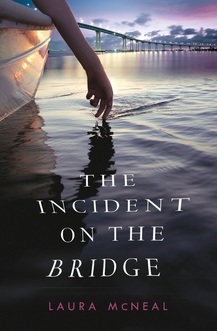Frequently Asked Questions
Person holding a freshly printed copy of The Incident on the Bridge: Sooooo, are you happy with it?
Me: Um, well, yeah, uh-huh. Sure.
 Publication is supposed to be the highlight of writing, where you feel all your hard work has come to glorious fruition, where you dance lightly on the steps in Philadelphia to the theme from Rocky.
Publication is supposed to be the highlight of writing, where you feel all your hard work has come to glorious fruition, where you dance lightly on the steps in Philadelphia to the theme from Rocky.
For six years, Thisbe Locke, the 17-year-old girl in this story, was my imaginary daughter, and her sister Ted was, too, and boys named Fenimore and Jerome were my imaginary sons and also my imaginary former selves, and a novel about them was, for that space of time, this imaginary perfect thing I could achieve if I just worked hard enough. For six years, I ran through the streets of Philadelphia/Coronado telling myself I MUST WRITE A BOOK THAT WILL SAY EVERYTHING I FEEL IN A BEAUTIFUL WAY THAT WILL DO JUSTICE TO ALL THE PAIN EVERYONE FEELS AND MAKE THEM FEEL BETTER BUT MORE THAN THAT I WISH SUICIDE FROM THE BRIDGE WOULD STOP.
Which made light dancing on the steps even harder than usual to achieve.
This novel, for what it's worth, is a re-telling of the Pyramus and Thisbe myth. Pyramus and Thisbe fall in love but are forbidden by their parents to see each other. They try to make do with talking through a crack in the wall between their two houses, but that isn’t enough, so they make a plan to meet somewhere, in a quiet little cemetery, at the Tomb of Ninus. Thisbe gets there first, and she encounters a lion that has just killed and eaten something. In terror, she runs away, dropping her scarf, which the blood-smeared lion gnaws on for a while, then drops. Pyramus thinks she’s dead, and he stabs himself. Thisbe finds his body, thinks her life is ruined, and stabs herself.
I always found this story to be even more unsatisfying than Romeo and Juliet. One of the worst myths of all time. Just ludicrous. You can’t really even feel bad for them, they’re so impulsive.
But I live on the far side of a 2-mile-long, 215-foot-tall bridge from which 360 people have killed themselves in the last 47 years. Some of them went to the high school our sons attend. Sometimes the bridge is closed for hours while a person paces back and forth near the 34-inch-high concrete rail. (There is no pedestrian lane, so to attempt to jump you must stand in a lane meant for cars.) Police used to keep one lane of the Coronado-San Diego Bay Bridge open for cars to pass through while a negotiator was trying to talk a suicidal person out of jumping, but, inevitably, as a trained counselor was earnestly telling the depressed person life was worth living, a driver in a passing car, enraged by the long delay, would shout, "JUMP!" Or, more frequently, "JUMP, A****!" So now all lanes are closed during a suicide intervention.
Sometimes, though, all that is found on the bridge is an empty car. The door may be open, the car still running, as if the driver couldn't wait a second longer, not even to kill the ignition.
 Every time this happens, it's somebody's job to come to the Tomb of Ninus. To ride to the base of the bridge in a boat and use the hook, lights, diving equipment, stretchers, or inflatable body bags fitted with ropes. It's someone's job to reach down into the water for people whose arms have broken in the fall, who are babbling incoherently, whose last gesture before falling was, in an instinct from childhood, to plug the nose. It's the job of others, in more delayed cases, to swim through silty, opaque water, through a concrete forest of poles, hoping to find the person but hopefully not to swim right into the face. It's someone's job, before or after the finding and retrieving, to go to the front door of the next of kin and say, "Your daughter" or "your son."
Every time this happens, it's somebody's job to come to the Tomb of Ninus. To ride to the base of the bridge in a boat and use the hook, lights, diving equipment, stretchers, or inflatable body bags fitted with ropes. It's someone's job to reach down into the water for people whose arms have broken in the fall, who are babbling incoherently, whose last gesture before falling was, in an instinct from childhood, to plug the nose. It's the job of others, in more delayed cases, to swim through silty, opaque water, through a concrete forest of poles, hoping to find the person but hopefully not to swim right into the face. It's someone's job, before or after the finding and retrieving, to go to the front door of the next of kin and say, "Your daughter" or "your son."
For this reason, I wanted Thisbe to live in a real world: mine. I wanted cell phones and fortune cookies to be the crack in the wall, and the Tomb of Ninus to be the bridge over which many people are driving this very second in a state of elation, worry, hope, distraction, haste, leisure, boredom, or despair.
Me: Um, well, yeah, uh-huh. Sure.
 Publication is supposed to be the highlight of writing, where you feel all your hard work has come to glorious fruition, where you dance lightly on the steps in Philadelphia to the theme from Rocky.
Publication is supposed to be the highlight of writing, where you feel all your hard work has come to glorious fruition, where you dance lightly on the steps in Philadelphia to the theme from Rocky. For six years, Thisbe Locke, the 17-year-old girl in this story, was my imaginary daughter, and her sister Ted was, too, and boys named Fenimore and Jerome were my imaginary sons and also my imaginary former selves, and a novel about them was, for that space of time, this imaginary perfect thing I could achieve if I just worked hard enough. For six years, I ran through the streets of Philadelphia/Coronado telling myself I MUST WRITE A BOOK THAT WILL SAY EVERYTHING I FEEL IN A BEAUTIFUL WAY THAT WILL DO JUSTICE TO ALL THE PAIN EVERYONE FEELS AND MAKE THEM FEEL BETTER BUT MORE THAN THAT I WISH SUICIDE FROM THE BRIDGE WOULD STOP.
Which made light dancing on the steps even harder than usual to achieve.
This novel, for what it's worth, is a re-telling of the Pyramus and Thisbe myth. Pyramus and Thisbe fall in love but are forbidden by their parents to see each other. They try to make do with talking through a crack in the wall between their two houses, but that isn’t enough, so they make a plan to meet somewhere, in a quiet little cemetery, at the Tomb of Ninus. Thisbe gets there first, and she encounters a lion that has just killed and eaten something. In terror, she runs away, dropping her scarf, which the blood-smeared lion gnaws on for a while, then drops. Pyramus thinks she’s dead, and he stabs himself. Thisbe finds his body, thinks her life is ruined, and stabs herself.
I always found this story to be even more unsatisfying than Romeo and Juliet. One of the worst myths of all time. Just ludicrous. You can’t really even feel bad for them, they’re so impulsive.
But I live on the far side of a 2-mile-long, 215-foot-tall bridge from which 360 people have killed themselves in the last 47 years. Some of them went to the high school our sons attend. Sometimes the bridge is closed for hours while a person paces back and forth near the 34-inch-high concrete rail. (There is no pedestrian lane, so to attempt to jump you must stand in a lane meant for cars.) Police used to keep one lane of the Coronado-San Diego Bay Bridge open for cars to pass through while a negotiator was trying to talk a suicidal person out of jumping, but, inevitably, as a trained counselor was earnestly telling the depressed person life was worth living, a driver in a passing car, enraged by the long delay, would shout, "JUMP!" Or, more frequently, "JUMP, A****!" So now all lanes are closed during a suicide intervention.
Sometimes, though, all that is found on the bridge is an empty car. The door may be open, the car still running, as if the driver couldn't wait a second longer, not even to kill the ignition.
 Every time this happens, it's somebody's job to come to the Tomb of Ninus. To ride to the base of the bridge in a boat and use the hook, lights, diving equipment, stretchers, or inflatable body bags fitted with ropes. It's someone's job to reach down into the water for people whose arms have broken in the fall, who are babbling incoherently, whose last gesture before falling was, in an instinct from childhood, to plug the nose. It's the job of others, in more delayed cases, to swim through silty, opaque water, through a concrete forest of poles, hoping to find the person but hopefully not to swim right into the face. It's someone's job, before or after the finding and retrieving, to go to the front door of the next of kin and say, "Your daughter" or "your son."
Every time this happens, it's somebody's job to come to the Tomb of Ninus. To ride to the base of the bridge in a boat and use the hook, lights, diving equipment, stretchers, or inflatable body bags fitted with ropes. It's someone's job to reach down into the water for people whose arms have broken in the fall, who are babbling incoherently, whose last gesture before falling was, in an instinct from childhood, to plug the nose. It's the job of others, in more delayed cases, to swim through silty, opaque water, through a concrete forest of poles, hoping to find the person but hopefully not to swim right into the face. It's someone's job, before or after the finding and retrieving, to go to the front door of the next of kin and say, "Your daughter" or "your son."For this reason, I wanted Thisbe to live in a real world: mine. I wanted cell phones and fortune cookies to be the crack in the wall, and the Tomb of Ninus to be the bridge over which many people are driving this very second in a state of elation, worry, hope, distraction, haste, leisure, boredom, or despair.
Published on May 01, 2016 09:21
No comments have been added yet.



